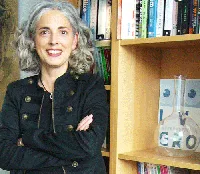
Now as an Assistant Professor in the Department of Biology at University of Toronto Mississauga, Jenkinson is a renowned expert in the field. Although her storied career has included stints at McMaster University and teaching in the Graduate Program in Biomedical Communications at the Institute of Medical Science in the Faculty of Medicine at U of T for nearly a decade, the field still has as strong an allure as ever. “When I was a student I learned so much from firsthand experience and it made me realize that wherever we can simulate those experiences, it would enhance learning,” says Jenkinson. “Anatomy for example, is a visual, spatial, three-dimensional, complex subject that students find difficult to learn with limited access to specimens and models.”
Jenkinson has also ventured into measuring the effectiveness of educational material in this area. She and her collaborator Gaël McGill from the Center for Molecular and Cellular Dynamics at Harvard Medical School have designed a series of molecular visualizations, which provide Biology students with a glimpse at the complexity of the molecular world. This is important because the ability to visualize proteins and understand how they function is a key component of areas such as cancer research. “Teachers, developers, and learners need to be more discerning in the design and consumption of visual tools,” says Jenkinson. “As a researcher my goal is to develop an understanding of how visually-rich media may be better used in teaching and learning.”
As part of their project, Jenkinson and McGill assessed students’ level of understanding and misconceptions about protein-protein interactions and dynamics. In their evaluation, they were interested in understanding how different visual variables map to the students’ performance on test questions that range from more straightforward fact-based to more abstract intuitions of protein behaviour at the molecular scale. Participants were randomly assigned to one of four groups, each comprising thirty to forty students, and were each asked to view an animation depicting a receptor-ligand binding event. With each version of the animation a new level of visual complexity was added. The group presented with most complex treatment of the event performed significantly better overall. Jenkinson attributes this to the immersive, high-resolution, 3-D environment in which the students are able to contextualize complexity more effectively than with static imagery. Using computer animation based on molecular research, students are now able to actually see how DNA is being replicated in living cells.
Being her first foray into this line of research, Jenkinson credits her preliminary success to the exciting results she and McGill have seen through their first grant, which was funded by the U.S.-based National Science Foundation. The experience has broadened both of their networks and opened up new opportunities for collaboration, and their work has served to further fuel Jenkinson’s curiosity about how it is that we perceive and learn information from visuals.
Her short-range goal now is to obtain funding for the next phase of the project. McGill and Jenkinson are currently working on a new grant application to the NSF, in hopes of developing a series of best practice guidelines. This time they will be looking at protein structure and conformational flexibility, with the aim of harnessing the techniques they have developed thus far through the use of visualization tools to be developed at Harvard and tested on participants at University of Toronto. They are also interested in integrating sound and interactivity to measure the effectiveness of these variables on scaffolding students’ understanding of complex scientific concepts. Given her combined expertise in biomedical visualization and educational evaluation, Jenkinson is optimistic that her work will lead to the development of better visualizations; by providing a framework and style guide for the development, the easier it will be for gifted artists and animators to become aware of and bring forth their creative talents to this field.
“Research in this area is still in its infancy. Molecular visualization is a rapidly expanding field and as the technology advances we need to establish a firm foundation upon which students can build,” says Jenkinson. “There’s always room for improvement and with every reiteration you can always learn new things.”
By Jerome Johnson
